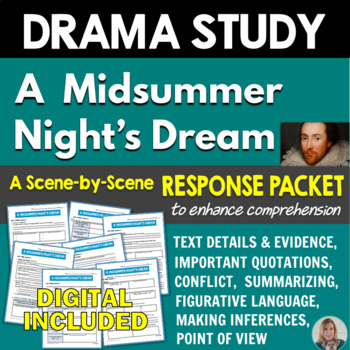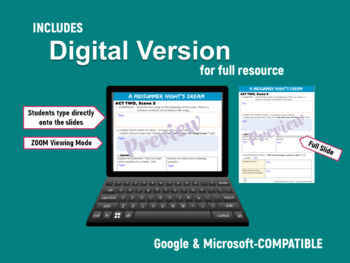A Midsummer Night's Dream: Response Packet - Print & DIGITAL
- Zip
- Google Apps™

What educators are saying
Description
A Midsummer Night's Dream Response Packet will help students keep track of all of the play’s exciting twists and turns. Now includes a digital version! Pages/slides are neatly designed in scene-by-scene sequence and focus on standards-based topics. Prompts include analyzing text details and evidence, conflict, important quotations, point of view, figurative language, making inferences, and summarizing.
Students enjoy working on the response pages with a partner or in small groups after reading each scene. This resource helps to reinforce comprehension and is also a great way to get students talking about the literature!
The digital version contains colorful slides where students type directly into text boxes. To access the digital version, you will find in the download
--a pdf with a link to the slides
--directions to access and share the resource with students
NOTE: This 14-page (and 16-slide) student reading packet is not meant to be a complete unit--it is offered to help students comprehend the events and understand characterization as they read, scene by scene.
A FULL ANSWER KEY is included.
------------------------------------------------------------------------------------------------------------------------------------------------------------------
STANDARDS EMBEDDED IN THIS RESOURCE:
RL.8, 9-10.1 Cite (strong and thorough) textual evidence to support analysis of what the text says explicitly as well as inferences drawn from the text
RL.9-10.3 Analyze how complex characters develop over the course of a text, interact with other characters, and advance the plot or develop the theme
RL.8.3 Analyze how particular lines of dialogue or incidents in a drama propel the action, reveal aspects of character, or provoke a decision
RL.8, 9-10.4 Determine the meaning of words and phrases as they are used in the text, including figurative meaning
RL.8.6 Analyze how differences in the points of view of the characters and the audience or reader create such effects as suspense or humor
Please open the PREVIEW.
Thanks! --Joy
You may like teaching with:
ELA Exit Tickets / Short Response Slips - Differentiated - for ANY Literature
ELA Bell Ringers - 240 Daily Warm Ups - Distance Learning Digital Included
Figurative Language STATIONS - Print & Digital Distance Learning
---Yes! Join my list to receive Teaching Tips, New Product Updates, and FREEBIES from Joy




